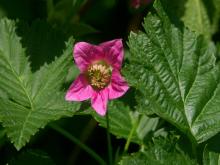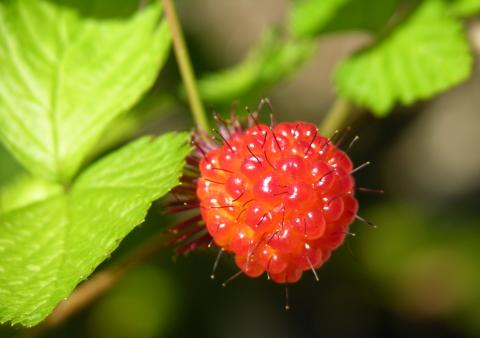
Image Credit: turtlepuddle.org
Common name(s): Salmonberry
General bloom time: flowers as early as March-July; fruit out May-June
Identification: woody perennial with scattered prickles; can grow to be about 4 meters in height
Leaves: leaves generally have three egg-shaped leaflets, are sharply double saw-toothed, dark green, deciduous, and can be anywhere from 7-22 cm long; leaves are sharply pointed at the tip with smooth or spare downy above and pale with felt-like hairs beneath
Flowers: distinctive with colors ranging from pink to red to magenta (common) to a rare reddish-purple; average 2-4 cm across with five pointed egg-shaped petal each; generally there are 1-2 per branch, though there can be as many as 4
Fruit: reddish-yellow to orange-red fruit are similar in appearance to raspberries; 1.5-2 cm in size; editable, sweet and slightly mushy
Habitat: moist to wet areas with nitrogen rich soils (forests, stream margins, flood-plains, swamps); low to subalpine elevations
Ecology: Salmonberry will form a dense thicket – an ideal spot for nesting birds and for small mammals. Many species of mammal including rabbits, beavers, porcupines, deer and elk browse the leaves, twigs and buds. Salmonberry flowering may coincide with the return of the Rufous Hummingbird.

Fun facts: Both the berries and the stem sprouts are eaten (the stem sprouts are often steamed)
- The berry is a favorite of the Swainson’s thrush, and the ripening of the berry is associated with the arrival of the bird which is called the salmonberry bird in many different languages
Places to find in Portland: Forest Park